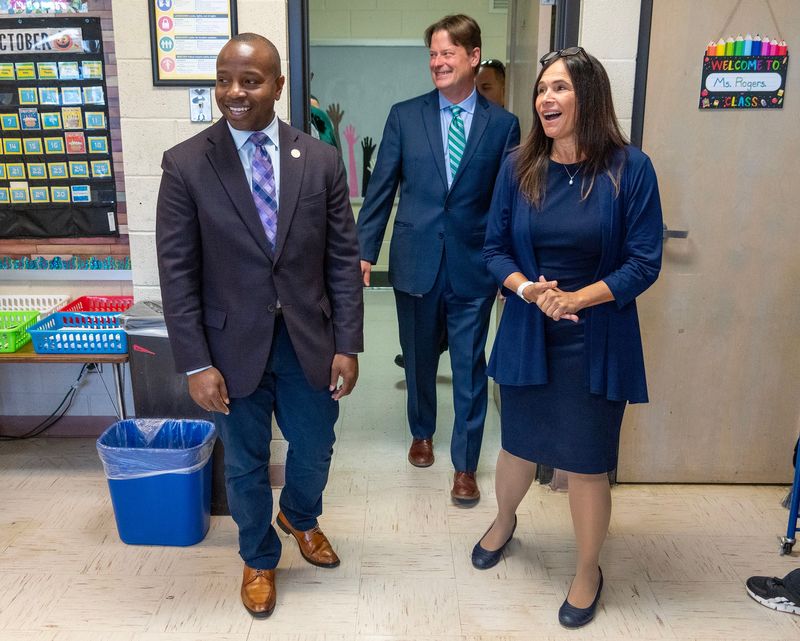Milwaukee School Board members approved an adjusted property tax levy Oct. 28 that translates to a rate of $9.46 per $1,000 of assessed value, officials reported — or about $1,892 for a $200,000 home.
The rate is eight cents higher than last year’s rate, or about $16 for a $200,000 home. It’s slightly under what Milwaukee Public Schools officials estimated when they asked city residents to approve a 2024 tax-hiking referendum to weather inflation.
As a result of the referendum, MPS was able to collect an additional $140 million in general revenue from state and local taxpayers last year, and an another additional $51 million this year. While city property taxpayers felt a substantial impact last year, the impact this year was dampened in part because the district is receiving more state funding — triggered by the district’s additional spending last year.
The tax rate is also tempered because of rising property values in the city, MPS Budget Director Nick Sinram said, dispersing the levy more thinly across each dollar of assessed value.
The levy adjustment approved unanimously Oct. 28 came with adjustments to the district’s budget. The school board had approved an initial $1.5 billion budget plan in June, but it always needs to adjust its plan in the fall after state aid payments are calculated.
The board approved some cuts and some new services as part of the adjustment, including a cut of 54 vacant positions, additional spending on the cleanup of lead-based paint hazards, and the addition of extracurricular activities. The Milwaukee Teachers Education Association had advocated for additional extracurriculars, which aren’t offered consistently across the district.
MPS Superintendent Brenda Cassellius also warned of more cuts to come as the district plans to close and merge schools in future years, facing a confluence of pressures.
The district’s enrollment fell by 2% this fall — part of a long downturn caused by declining birth rates and competition from other schools. State funding allowances haven’t kept up with inflation, leaving the district to turn to local property taxpayers to fill some budget holes as other gaps remain. Federal funding sources have uncertain futures.
“We are presenting a responsible budget that manages our current resources and also looked at every opportunity for efficiencies to start looking at a structurally balanced budget for future years,” Cassellius said.
MPS increases levy for Recreation Department for future budget flexibility
On top of the expected increase in state funding, the district received about $37 million more in general state aid this fall than it had anticipated, after the state’s complex funding formula calculations. The unexpected state funding means MPS can’t collect as much funding as planned from city property taxpayers for its basic operations, as its general spending is capped by state-imposed revenue limits.
That could have allowed for some property tax relief. However, the state’s limits don’t apply to the district’s Recreation Department, which is considered a broader community-serving arm of the district. MPS officials decided to raise the property tax levy for the district’s Recreation Department by about $36 million, offsetting the reduction to the levy for the district’s operations.
Researchers at the Wisconsin Policy Forum, which has long monitored MPS’ budgeting, said the choice to raise the Recreation Department’s levy is important to explain to residents for robust public engagement. On one hand, said senior researcher Sara Shaw, there’s the “laudable goal” of maximizing funding for public services, and on the other, there was the possibility of lowering property taxes.
“This is a real opportunity for public engagement because there are competing values here, and they are all values that have merit,” Shaw said. “That should be where some of our richest public dialogue can happen.”
The increased funding for the Recreation Department will go into the department’s reserve.
In an interview with the Journal Sentinel, Cassellius said those funds could be used in the future for recreational programs or facilities, including a new community center on the city’s northwest side, which Cassellius said could go over its initial budget because of inflation. Additionally, as the district considers closing and merging schools, Cassellius said the money could support new or improved recreational facilities at schools receiving displaced students.
The funds could also be used for future flexibility in the district’s tax levy. If the district wants to increase its local property tax levy in future years for its operations — possibly to account for any drop in state funding, or to support a new referendum — it would have the option to reduce the Recreation Department’s levy to offset the impact to taxpayers, as the Recreation Department could then draw on its reserves.
The district did just that last year at this time, after learning its state aid would be reduced because of a previous overpayment caused by the district’s accounting errors.
Additional special education funding and grants allow more spending, reduction in vacancies
Outside of the district’s general funding, MPS is also on track to receive more public grants and special education funding than expected. State lawmakers this summer approved additional special education funding to cover about 40% of districts’ costs, up from 30%, which MPS officials said means an additional $20 million in special education funds for the district.
Those funds aren’t restricted by the state’s revenue limits, meaning the district can spend more than anticipated when it passed its June budget. Administrators added spending in the following areas:
The district will also use the funding to fill additional vacancies, Cassellius said. In its initial budget plan, MPS planned to save about $76 million from unfilled vacancies during this school year. Cassellius, who has prioritized filling positions, reduced that by $22 million in the budget presented Oct. 28.
Some of that reduction is achieved by cutting vacant positions — about 54 of them — while the district works to fill other vacant positions. Cassellius earlier this month announced a hiring bonus for formerly retired MPS teachers. The district is hosting eight hiring fairs over the next two months.
MPS draws more from trust for lead cleanup
In the biggest change to the district’s initial spending plan, MPS officials added $24.3 million in spending on facilities, drawing from reserves in its capital improvement trust fund.
Most of that spending — $19.1 million — is for costs associated with addressing lead paint hazards, discovered throughout the district earlier this year. That’s on top of $15.9 million that MPS officials had already pulled from that trust account for lead cleanup.
Contact Rory Linnane at rory.linnane@jrn.com.
This article originally appeared on Milwaukee Journal Sentinel: MPS sets property tax rate, adjusts budget plan, preps for unknown future
Reporting by Rory Linnane, Milwaukee Journal Sentinel / Milwaukee Journal Sentinel
USA TODAY Network via Reuters Connect


